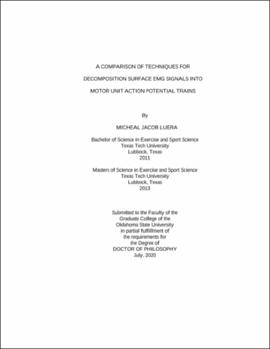| dc.contributor.advisor | DeFreitas, Jason | |
| dc.contributor.author | Luera, Michael Jacob | |
| dc.date.accessioned | 2021-02-22T22:24:07Z | |
| dc.date.available | 2021-02-22T22:24:07Z | |
| dc.date.issued | 2020-07 | |
| dc.identifier.uri | https://hdl.handle.net/11244/328613 | |
| dc.description.abstract | Advancements in surface electromyography (sEMG) have led to many discrepancies in techniques used for signal decomposition. Specifically, the capabilities of well-established recording systems, and the methods involved in identifying motor unit (MU) action potentials and respective firing behaviors. | |
| dc.description.abstract | PURPOSE: To examine the differences in MU identification and validation procedures, and firing behaviors between a four-channel (4-ch) sensor and a sixty-four channel (64-ch) high-density sEMG array. | |
| dc.description.abstract | METHODS: Following 2 maximal voluntary contractions (MVC), ten (23 ± 3 yrs.; 178.64 ± 5.82 cm; 177.8 ± 17.37 kg) lower body resistance trained males performed 10 sec submaximal isometric ramp contractions of the knee extension exercise at 10%, 20%, and 50% MVC. During testing sEMG was recorded from the vastus lateralis using both 4-ch and 64-ch sensors. Signals were separately decomposed into their constituent MU action potential trains and were further validated for subsequent analysis of firing behaviors. The slope and y-intercept were calculated across the relationships between recruitment threshold versus mean firing rate (RT/MFR). A 2-way mixed factorial ANOVA (sensor [4-ch vs 64-ch] x contraction intensity [10% vs 20% vs 50%]) was used to examine mean differences in MU yield during all contraction. For validated MUs, the RT/MFR relationships were compared between sensors at each intensity and a paired samples t test was used to compare differences in RTs. | |
| dc.description.abstract | RESULTS: There was a significant interaction between sensor and intensity, as well as a main effect for intensity, with follow up analysis revealing a significant difference between MUs validated at 10% and 50% MVC (p < 0.05). There was a significant difference in slopes at 10% and 50% MVC, and y-intercepts at 20% MVC for RT/MFR relationships (p < 0.10) and the RT of validated MUs were significantly different (p <0.5) between sensors at each intensity. | |
| dc.description.abstract | CONCLUSION: MUs validated using the 4-ch sensor yielded a greater numbers during higher contraction intensities versus the 64-ch sensor. The inability of the 64-ch sensor to yield a greater amount of MUs at 50% MVC may have been due to the subjectivity of the manual editing procedures. However, both validation procedures eliminated a high amount of decomposed MUs. | |
| dc.format | application/pdf | |
| dc.language | en_US | |
| dc.rights | Copyright is held by the author who has granted the Oklahoma State University Library the non-exclusive right to share this material in its institutional repository. Contact Digital Library Services at lib-dls@okstate.edu or 405-744-9161 for the permission policy on the use, reproduction or distribution of this material. | |
| dc.title | Comparison of techniques for decomposing surface EMG signals into motor unit action potential trains | |
| dc.contributor.committeeMember | Jenkins, Nathaniel | |
| dc.contributor.committeeMember | Trevino, Michael | |
| dc.contributor.committeeMember | Hausselle, Jerome | |
| osu.filename | Luera_okstate_0664D_16879.pdf | |
| osu.accesstype | Open Access | |
| dc.type.genre | Dissertation | |
| dc.type.material | Text | |
| dc.subject.keywords | decomposition | |
| dc.subject.keywords | electromyography | |
| dc.subject.keywords | mean firing rate | |
| dc.subject.keywords | motor unit | |
| dc.subject.keywords | recruitment threshold | |
| dc.subject.keywords | validation | |
| thesis.degree.discipline | Health and Human Performance | |
| thesis.degree.grantor | Oklahoma State University | |
